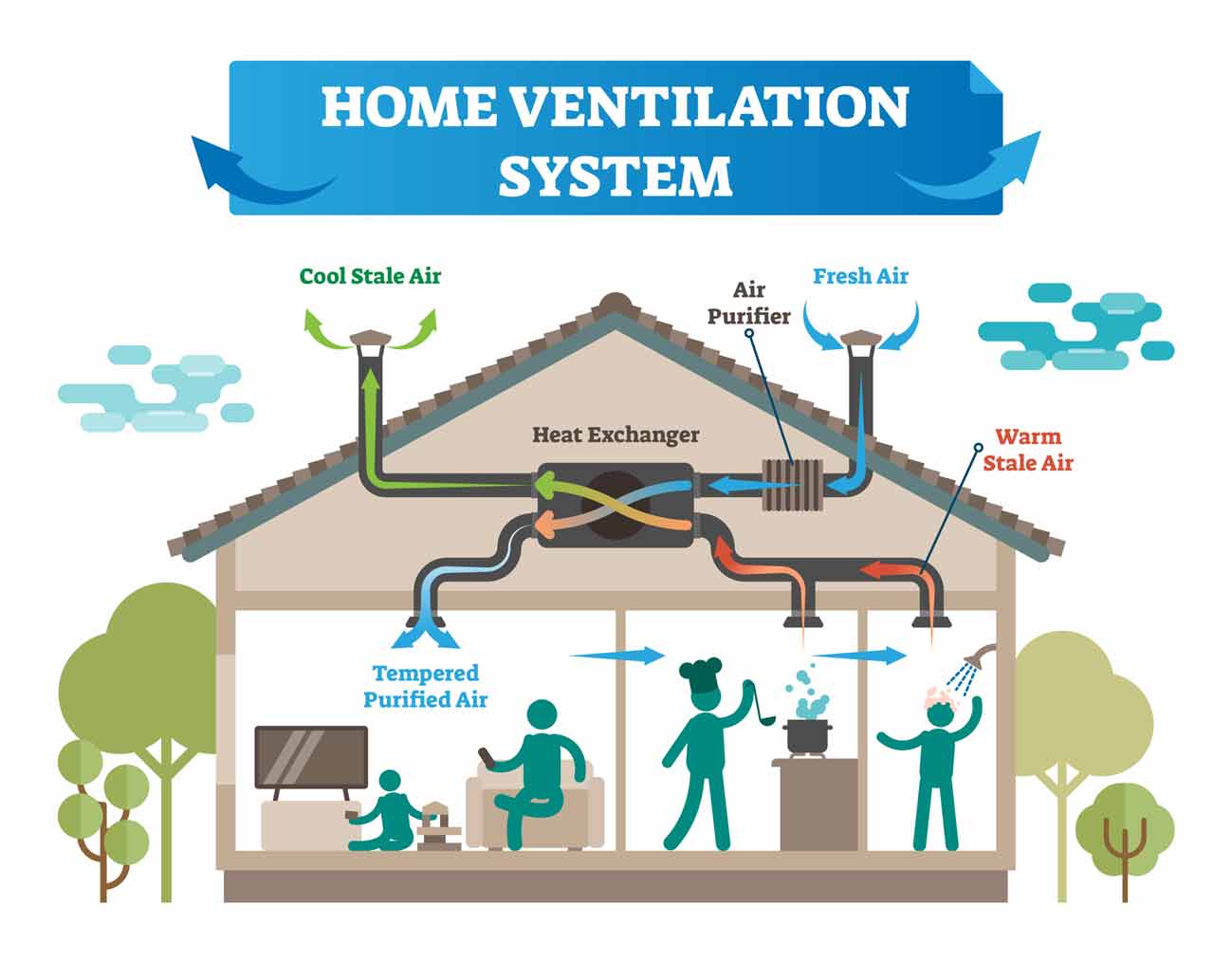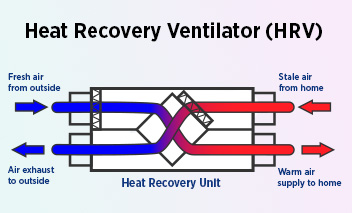Action Plan: What to Consider Before Choosing HRV
Wiki Article
Unveiling the Trick Perks and Uses of Heat Recovery Ventilation in Sustainable Style
Heat Recovery Ventilation (HRV) systems play a necessary function in lasting style. They assist in a continuous exchange of stagnant indoor air with fresh exterior air, considerably boosting indoor air top quality. HRVs contribute to power performance by redeeming heat from worn down air, which can reduce energy expenses. Comprehending the diverse benefits and applications of HRVs exposes their significance in modern-day architecture. What other benefits do these systems supply in the search of sustainability?Recognizing Heat Recovery Ventilation Systems
Heat recovery ventilation (HRV) systems are developed to improve indoor air quality while reducing power loss. These systems make use of a mechanical ventilation strategy to exchange stale indoor air with fresh outdoor air, ensuring a continual supply of clean air. By recording warm from the exhaust air, HRVs prerequisite incoming air, minimizing the demand on heating and cooling systems. This process not only enhances thermal comfort however additionally adds to energy performance in residential and business buildings. Additionally, HRV systems assist manage moisture degrees and reduce interior pollutants, promoting a healthier living atmosphere. Their calculated execution is essential for attaining lasting design goals, as they use a balance in between energy conservation and occupant health.Exactly How HRV Systems Job
While many might know with ventilation systems, comprehending exactly how warm healing ventilation (HRV) systems operate is vital for valuing their benefits. HRV systems function by exchanging stagnant indoor air with fresh outside air while transferring warmth between the 2 streams. This procedure takes place in a warmth exchanger, where warmth from the outgoing air warms up the incoming air throughout cooler months, minimizing energy loss. Conversely, in warmer months, the system can cool inbound air utilizing the cooler outgoing air. HRVs are geared up with fans to promote air movement and filters to remove particulates, making certain a continuous, well balanced ventilation process. This cutting-edge layout not only improves energy performance yet additionally adds to keeping a comfy interior setting.Enhancing Indoor Air Top Quality
Interior air quality can significantly affect wellness and wellness, making effective ventilation crucial in modern-day homes. Heat Recovery Ventilation (HRV) systems play an important function in maintaining interior air top quality by constantly trading stagnant indoor air with fresh outdoor air. This process not just decreases airborne contaminants however likewise reduces moisture levels, which can result in mold and mildew growth and respiratory system problems. HRV systems filter inbound air, removing allergens and particulates, therefore supplying a much healthier living atmosphere. Furthermore, these systems aid remove smells and volatile natural substances (VOCs) frequently located in home items. By making certain a constant flow of clean air, HRV systems add to a total improved interior environment, promoting convenience and wellness for owners.Energy Efficiency and Cost Cost Savings
Power efficiency stands apart as a considerable advantage of Heat Recovery Ventilation (HRV) systems. By recording and recycling the heat from exhausted indoor air, HRVs decrease the power required for home heating inbound fresh air, leading to reduced power intake. This performance equates into lower utility costs, offering significant expense financial savings for home owners and companies alike. Furthermore, HRV systems commonly receive power efficiency rewards and rebates, even more enhancing their financial allure. With time, the initial financial investment in HRV modern technology can bring about a positive roi through decreased power expenditures. Subsequently, the combination of HRV systems not only advertises sustainable design yet also gives a functional option for accomplishing long-lasting energy financial savings and monetary advantages.Ecological Benefits of HRV

A wide range of environmental advantages arises from the application of Heat Recovery Ventilation (HRV) systems. By successfully moving heat from exhaust air to incoming fresh air, HRVs considerably decrease the energy required for home heating and cooling spaces. This power performance equates to lower greenhouse gas emissions, adding to a decline in the overall carbon footprint of buildings. Furthermore, HRV systems boost indoor air high quality by continually distributing fresh air, thus lowering the concentration of interior pollutants and irritants. The decrease in power intake aids in saving all-natural resources, making HRVs a vital component of lasting style. Generally, the ecological advantages of HRVs play a crucial function in promoting a much healthier planet and fostering environmentally friendly building practices.
Versatile Applications in Modern Architecture
Heat recovery ventilation (HRV) systems are progressively being integrated right into both residential and commercial architectural projects. In property setups, HRVs boost indoor air quality while making the most of power effectiveness. At the same time, in business areas, these systems maximize air flow techniques, showing their flexibility in modern-day directory architectural applications.Residential Projects Combination
While modern style progressively emphasizes sustainability, the combination of warm healing ventilation systems in domestic projects has become a sensible solution for improving indoor air high quality and energy efficiency. These systems effectively move warmth from exhaust air to inbound fresh air, minimizing energy loss and decreasing home heating or cooling down needs. In new builds and retrofits alike, warmth recuperation air flow can be flawlessly included, offering property owners with a much healthier living setting while reducing energy costs. Additionally, with enhancing understanding of ecological effects, more architects and contractors are acknowledging the lasting advantages of these systems. Consequently, heat healing air flow has actually ended up being an important part of lasting property layout, showcasing convenience and dedication to eco-friendly practices.Business Areas Optimization
As modern-day commercial spaces evolve to meet the demands of sustainability and effectiveness, the application of warm recovery ventilation systems becomes a vital technique for maximizing indoor environments. These systems help with the exchange of stagnant indoor air with fresh exterior air while recovering warmth power, substantially lowering energy intake. This not just boosts convenience for passengers but additionally helps in decreasing operational prices. Flexible applications can be observed in offices, retail spaces, and universities, where air high quality and temperature level control are extremely important. In addition, integrating heat recovery ventilation straightens with green building qualifications, further advertising ecological duty. Ultimately, taking on such systems in industrial style not only adds to sustainability objectives however additionally cultivates much healthier, extra productive spaces for users.
Integrating HRV Into Sustainable Design Practices
Incorporating warmth recuperation air flow (HRV) systems into sustainable style methods uses substantial advantages in energy efficiency and interior air top quality. By utilizing HRV, developers can produce economical options that not only reduce energy intake yet additionally boost the overall comfort of interior environments. This alignment with sustainability objectives positions HRV as a vital part in modern architectural approaches.
Power Effectiveness Improvement
By including heat recuperation ventilation (HRV) systems right into sustainable layout methods, architects and home builders can considerably boost energy performance in contemporary building and constructions. HRV systems function by recording warmth from outbound stale air and moving it to incoming fresh air, minimizing the power needed for heating or cooling indoor spaces. This procedure not only lowers reliance on standard HVAC systems but additionally lowers general energy intake. On top of that, HRV systems can assist keep a consistent interior temperature, minimizing peak power demands. By integrating these systems, structures can attain considerable decreases in utility prices and carbon footprints, aligning with sustainability goals. Ultimately, HRV innovation represents a practical service for boosting energy efficiency in the constructed environment, advertising more accountable resource use.Indoor Air Quality Enhancement
How can heat recuperation ventilation (HRV) systems add to remarkable indoor air quality in modern-day buildings? HRV systems successfully exchange stagnant indoor air with fresh outside air while recovering heat, reducing temperature level fluctuations. This procedure minimizes the focus of indoor toxins, such as volatile organic compounds (VOCs), irritants, and wetness, which can degrade air quality and effect passenger health and wellness. By preserving ideal moisture degrees and making sure a continual supply of tidy air, HRVs aid create a healthier indoor environment. Additionally, these systems can be integrated into lasting straight from the source style practices, promoting energy performance alongside enhanced air high quality. HRV Heat Recovery Ventilation. As a result, HRV technology plays a crucial duty in progressing total owner convenience and health in contemporary building stylesAffordable Style Solutions

Often Asked Questions
What Maintenance Is Needed for Heat Recovery Ventilation Systems?

Maintenance for warm recovery air flow systems normally involves routine filter substitutes, cleaning of heat exchangers, inspection of fans and air ducts, and guaranteeing correct drain. These jobs help keep performance and lengthen the system's life expectancy in time.
Can HRV Equipments Be Set Up in Existing Buildings?
Heat recovery ventilation systems can undoubtedly be installed in existing structures. HRV Heat Recovery Ventilation. Retrofitting calls for cautious preparation and evaluation of the structure's layout, making certain compatibility with present systems while making the most of power effectiveness and indoor air qualityExactly How Do HRV Systems Impact Sound Levels Inside?
HRV systems can influence interior sound degrees by presenting sound from outside resources via air flow. High-grade setups usually include sound-dampening features, reducing noise impact while providing efficient air exchange and keeping comfort inside your home.Are There Any Kind Of Downsides to Utilizing HRV Systems?
The disadvantages of making use of HRV systems consist of possible high preliminary prices, upkeep challenges, and the possibility of lowered interior air high quality if filters are not on a regular basis transformed, which might result in concerns with humidity levels.Exactly how Do I Pick the Right HRV System for My Requirements?
Picking the appropriate warm healing air flow system involves reviewing particular demands, such as constructing size, environment, and energy efficiency goals. Additionally, evaluating system functions, setup requirements, and upkeep considerations is crucial for peak performance and complete satisfaction.Report this wiki page